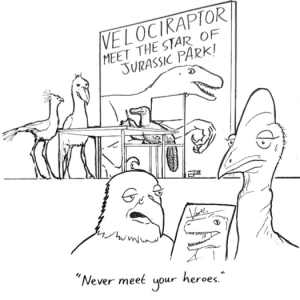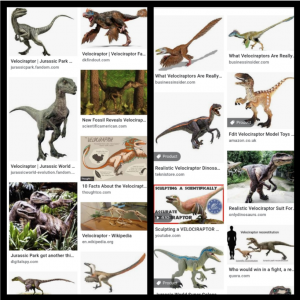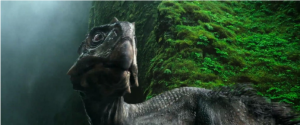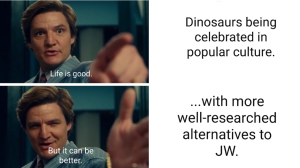This is a guest post from The Bristol Dinosaur Project blog. With thanks to Rhys Charles for the share.
Guest Author: James Ormiston
Palaeontology & Evolution MSci Graduate / Palaeoartist
From Science to Sensation
A short while ago, dark blurry YouTube uploads began appearing of two big dinosaurs fighting in IMAX cinemas. These were covertly-filmed showings of the first few minutes of the next instalment in the biggest dino-franchise of all: Jurassic World Dominion. Though the official global reveal was some way away, these low-quality videos revealed some intriguing details. The online community immediately began picking it apart…and battle lines were drawn. A debate as old as the franchise itself was about to fire up again.

To heavily paraphrase, some comment threads went a little like this:
“This is awesome!”
“Is that Giganotosaurus?! I’m so excited!”
“Look! Feathers! They finally did it!”
“Wait, those two dinosaurs didn’t live together or at the same time, what’s up with that?”
“So what, it’s a movie, it doesn’t have to be accurate!”
“Yeah it’s just entertainment, not a documentary.”
“I’m excited for it anyway. It’ll be a fun movie like the others.”
…and so on. This debate actually gets rather heated sometimes, but the general disagreement comes from roughly the same thing: should the Jurassic World franchise have made their dinosaurs more scientifically accurate, since scientists have now known for a long time that they didn’t actually look like how Jurassic Park originally showed them? This argument is especially relevant to the upcoming Dominion, because it includes “flashback” scenes of the Mesozoic showing its prehistoric cast on home turf. No longer is it only concerned with resurrected genetically modified monsters; this seems to be the first franchise entry to attempt showing the dinosaurs as they originally were.
I won’t list all the foibles and inaccuracies so far pointed out by palaeontologists and enthusiasts alike, because that could take an entire article in itself. Nor am I going to tell you that Jurassic World is a bad film series as a result, because I don’t think it is. I also don’t want to suggest that people aren’t allowed to like the depictions presented in it just because they aren’t accurate. Instead, I’m going to ask a more general question…
Does it really matter?
To say that the original Jurassic Park was influential would be a colossal understatement. Not only is it THE dinosaur movie, it’s one of the most highly-praised cinematic works of all time. You’d be hard pressed to find a dinosaur palaeontologist who wasn’t influenced by it in some way, and it managed to almost completely change the public’s perception of dinosaurs as animals. Like Jurassic World, it still had its share of inaccuracies. Supposedly Samuel Welles, who first described Dilophosaurus, despaired at Jurassic Park’s famously over-the-top depiction of his dinosaur, but he still acknowledged it as a good monster movie. Even today that fictionalised association with a frill and venom clings to the public mind-set…and to some that persistence is troubling.
All the way back to the books, we are told that the dinosaurs in Jurassic Park/World are not “real” dinosaurs. They’ve been hacked together with what DNA fragments InGen and its rivals/successors recover, merged with that of modern animals and in some cases intentionally altered for scare-factor. They are basically GMOs, so we shouldn’t expect them to be scientifically accurate, like how Ice Age and The Land Before Time are obviously cartoons and shouldn’t be too closely scrutinised.
But for 1993 Jurassic Park was actually roughly in line with palaeontological understanding of the day. Spielberg’s team did a lot of consultation with palaeontologists to make the dinosaurs realistic even though, according to the story, they don’t have to be (and indeed, like in Dilophosaurus’ case, sometimes they intentionally aren’t). The Dinosaur Rennaisance of the late 20th century, when scientists realised that they were not just lumbering lizards, was finally taken on board by the general public thanks to Jurassic Park showing it to them in an engaging way. That was a REALLY big deal.
22 years later, Jurassic World then emphasised that (in the story universe) the public didn’t want accuracy, they wanted dinosaurs to be scary. That’s the explanation given for not changing the dinosaur designs in ‘World despite over 20 years of real life post-‘Park research suggesting (with very little room for debate) that they should look different. Both films have inaccuracies, but that’s mainly due to one being an earnest attempt at realism made a long time ago, and the other deliberately choosing to keep its reconstructions in that era. As a result, one could easily interpret ‘World as inherently far more misleading. Our view of dinosaurs has indeed changed quite a lot since 1993, in fact some are referring to the 21st century as an age of dinosaur re-discovery.
But that’s still basically ok, right? After all Jurassic World is just entertainment, like the fictional attraction itself. Jurassic World’s shareholders wanted people to be excited, so keeping the dinosaurs the same (and adding made-up new ones) was safer than the financial risk of dinosaurs being scientifically accurate (feathered raptors? What’s so scary about a 6-foot turkey?!). They aren’t treated like real animals; they are treated like characters.
The dinosaurs are brand icons, so why change what people love? It’s quite funny because, intentionally or not, Jurassic World feels like a parody of itself in this regard. Besides, it’s not like knowing how dinosaurs looked is way up on the list of “Scientific Things You Should Definitely Know About in Every Day Life.” It’s hardly as practical and relevant as re-wiring a plug, acknowledging climate change or understanding vaccines. People who are really interested in dinosaurs can just look it up on the internet, and discover that all was not as it seemed on screen.

However, I think it’s still relevant to the legacy of the original film and the franchise’s wider responsibility as a STEM promoter. How has it repaid all those people who were inspired to become palaeontologists by the first film’s attention to detail, along with existing researchers, who then greatly advanced our knowledge even further in the years following its release? By ignoring all their hard work and using a plot device to cover that decision? Now the franchise is attempting to show the actual time of the dinosaurs, and the genetic modification thing doesn’t really apply to those. In fact I’d say it adds confusion because it addresses one well-known inaccuracy (lack of feathers) while keeping others.
Well, that’s a bit cynical of me to say, but still, from my experience talking to people at outreach events across the UK it seems that many do still take the franchise’s outdated depictions at face value. Evidently not everyone watching has taken the idea of the dinosaurs not being “real” on board. Is it not obvious enough, or do people just subconsciously prefer the inaccurate versions out of familiarity? More importantly though, what are viewers then meant to take away from this about what dinosaurs should look like, and how we know that? What can the average viewer compare it to? How often do you see the Jurassic-style raptor in other media (including things like memes, logos, murals, tattoos, or webcomics) in place of a realistic one, simply because it’s more recognisable to a general audience than a feathered one? Unless specifically referencing Jurassic Park/World, according to the movies’ own lore, other depictions that copy them are by definition not actually dinosaurs.
The up-to-date information is out there, but it would be nice to give that information some kind of solid platform in popular culture, which the public can immediately use for reference and a starting point. Then they don’t have to sift through potentially outdated, misleading, or even boring (to the average non-expert) sources to learn more about their favourite dinos. And this assumes they even want to have to do much or any reading; many might rather just watch something instead. Jurassic World had the potential to be that watchable platform and continue one of Jurassic Park’s greatest legacies.

The fact remains that scientists and outreach educators are still, after nearly 30 years, having to dispel public misconceptions dating back to the first film (looking at you, Dilophosaurus). Some people (none of whom I’ve yet observed to be palaeontologists) even approach the opposite end of the scale and suggest that, because we still don’t yet 100% know what many dinosaurs looked like, accuracy in movie depictions doesn’t matter because it’ll just change again in a few years. I’m not a fan of this argument at all, as it oversimplifies the issue and shows a more subtle disconnection between the public and the research community.
On the face of it, it’s good to acknowledge that science changes. Indeed, we certainly do have some way yet to go; the fossil record is notoriously incomplete. Yes, some things have changed, but among them are changes supported by strong new evidence (much of which isn’t even very new anymore).
Just because dinosaurs’ appearances will probably change in the future doesn’t mean mainstream media can be excused for ignoring basic aspects of current understanding that are no longer widely controversial among scientists. Scientists who, ironically, are more numerous than ever before thanks largely to being inspired to enter the field by Spielberg’s Jurassic Park. Interstellar’s black hole was generated based on guidance from a team of 30 people’s theoretical physics equations, but even that may become outdated tomorrow…maybe it already is (again ironically, I don’t know because I’m not familiar with theoretical physics). It was still worth it for the spectacle and appreciation for the science.
Just look at the Senckenberg Museum’s Psittacosaurus with its preserved skin and other soft tissues. It’s an amazing specimen, and only takes us further along routes which modern palaeontology predicted long ago (striking colour patterns like modern animals, varying bodily coverings like bristles, lack of shrink-wrapping), leaving Jurassic World’s depictions even further behind the curve. One of the most fascinating things about dinosaurs is precisely that our view of them keeps changing, but at the same time some modern revelations (like un-pronated theropod wrists and feathered raptors, the former being a really basic, inoffensive thing which is extremely easily fixed) have become well-established by consensus and therefore unlikely to change any time soon.
The BBC’s 2011 documentary Planet Dinosaur quite bravely demonstrated this balance of discovery, observation and speculation pretty well, even though it too succumbed to new evidence almost immediately in its finer details. The public, which by-and-large adores dinosaurs, deserves more than outdated tropes. Should we expect movies to go all-out and feature all the very latest research? No. Should we hope for them to at least move on from 1993? I mean, Transformers: Age Of Extinction gave it a go, even though its Psittacosaurus was still mostly otherwise inaccurate (the bristles had been known about since the early 2000s)…


But still, we must consider again the target audience. Jurassic World acts on two main concepts: excitement and familiarity. Universal will have wanted to excite new (mainly younger) viewers and appeal to people (many of whom will be parents of said younger viewers) who fondly remember Jurassic Park. I expect people strongly advocating for scientific accuracy mostly fall into the latter camp, because they are more likely to be enthusiasts and academics inspired to pursue the field by the original movie (as a child of ’94 with a palaeontology degree, I’m in that camp too). They are also almost certainly a minority.
To the studio, these people alone were likely not very high up the list when it came to deciding who to cater to. The majority of casual viewers will not care about accuracy, but that in itself is fuelled by simple lack of awareness due to Jurassic Park reigning almost unchallenged in dinosaur media. The movie industry probably couldn’t predict how modern mainstream audiences would react to significantly updated dinosaurs…because they basically haven’t been given any since 1993*. The safer option to guarantee excitement through familiarity, therefore, was to keep the dinosaurs largely unaltered. And while it’s fine that people do indeed like what’s familiar, I (and many others) think it was a wasted opportunity to assume they wouldn’t like even slightly updated ones.
So, on the one hand, Jurassic World not showcasing palaeontology’s major developments since the 90s has been a bit of a slap in the face for the field of science it owes its existence to. Dominion may end up being an improvement, but some aren’t holding out hope. On the other hand, misleading the public about dinosaurs isn’t really a tangible problem with any significant negative consequences for society, nor even entirely Jurassic World’s fault since there is a plot-based reason given (even if it feels more like an excuse to not take risks); it’s also not helped by a reluctance in the wider movie industry to come up with any well-researched competition. I’ll come onto that next…
*If anyone has access to audience surveys, focus group minutes and the like proving or disproving this suspicion, then do share them! I’m prepared to be wrong as someone who doesn’t work in the movie industry.

Part Two will be coming out tomorrow!!
Preview… “So far what I’ve done is over a thousand words of moaning, and excessive moaning adds fuel to the weird factionalism that’s appeared in the wake of this debate. So, what can actually be done about it? “
James Ormiston graduated from the Palaeontology & Evolution MSci at the University of Bristol in 2016. He is now a palaeoartist (@notsimro) and lab technician.

